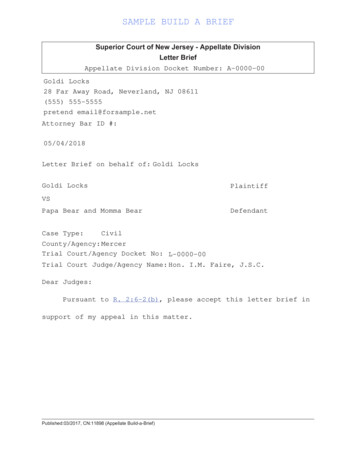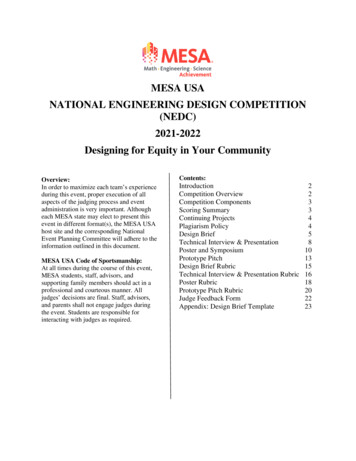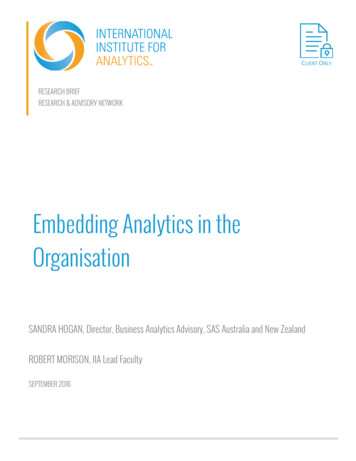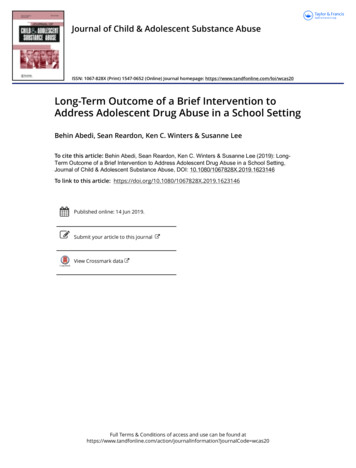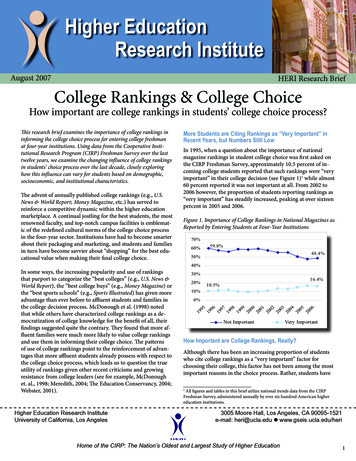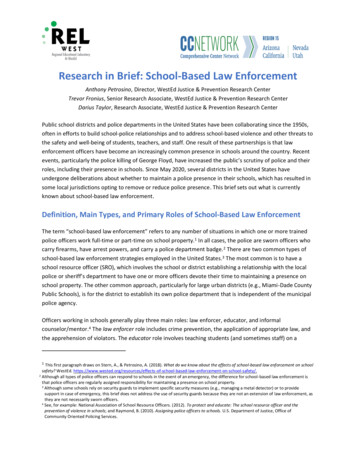
Transcription
Research in Brief: School-Based Law EnforcementAnthony Petrosino, Director, WestEd Justice & Prevention Research CenterTrevor Fronius, Senior Research Associate, WestEd Justice & Prevention Research CenterDarius Taylor, Research Associate, WestEd Justice & Prevention Research CenterPublic school districts and police departments in the United States have been collaborating since the 1950s,often in efforts to build school-police relationships and to address school-based violence and other threats tothe safety and well-being of students, teachers, and staff. One result of these partnerships is that lawenforcement officers have become an increasingly common presence in schools around the country. Recentevents, particularly the police killing of George Floyd, have increased the public’s scrutiny of police and theirroles, including their presence in schools. Since May 2020, several districts in the United States haveundergone deliberations about whether to maintain a police presence in their schools, which has resulted insome local jurisdictions opting to remove or reduce police presence. This brief sets out what is currentlyknown about school-based law enforcement.Definition, Main Types, and Primary Roles of School-Based Law EnforcementThe term “school-based law enforcement” refers to any number of situations in which one or more trainedpolice officers work full-time or part-time on school property.1 In all cases, the police are sworn officers whocarry firearms, have arrest powers, and carry a police department badge.2 There are two common types ofschool-based law enforcement strategies employed in the United States.3 The most common is to have aschool resource officer (SRO), which involves the school or district establishing a relationship with the localpolice or sheriff’s department to have one or more officers devote their time to maintaining a presence onschool property. The other common approach, particularly for large urban districts (e.g., Miami-Dade CountyPublic Schools), is for the district to establish its own police department that is independent of the municipalpolice agency.Officers working in schools generally play three main roles: law enforcer, educator, and informalcounselor/mentor.4 The law enforcer role includes crime prevention, the application of appropriate law, andthe apprehension of violators. The educator role involves teaching students (and sometimes staff) on a1This first paragraph draws on Stern, A., & Petrosino, A. (2018). What do we know about the effects of school-based law enforcement on schoolsafety? WestEd. -based-law-enforcement-on-school-safety/.2 Although all types of police officers can respond to schools in the event of an emergency, the difference for school-based law enforcement isthat police officers are regularly assigned responsibility for maintaining a presence on school property.3 Although some schools rely on security guards to implement specific security measures (e.g., managing a metal detector) or to providesupport in case of emergency, this brief does not address the use of security guards because they are not an extension of law enforcement, asthey are not necessarily sworn officers.4 See, for example: National Association of School Resource Officers. (2012). To protect and educate: The school resource officer and theprevention of violence in schools; and Raymond, B. (2010). Assigning police officers to schools. U.S. Department of Justice, Office ofCommunity Oriented Policing Services.
variety of topics related to crime, the law, and positive decision-making. The informal counselor/mentor roleinvolves aiding students (and, at times, their families) with law-related and other issues.Growth of and Funding for School-Based Law EnforcementThe number of school districts with police presence in their schools has increased dramatically in the lastseveral decades. Although there are several factors theorized as being responsible for this growth,5 concernsabout crime and violence in the schools have been one driver. Only one percent of schools reported astationed law enforcement officer present in the 1970s. 6 Federal survey data from academic year 2017-2018indicates that nearly 50% of all schools have sworn police officer presence at least one day per week; forschools with 1,000 or more students, the percentage increases to nearly 80%.7 Among secondary schools,61% have police or security presence at least one day per week; this is up from 42% in academic year 20052006. 8 Three presidential administrations (Clinton, Obama, and Trump) have authorized increases to federalfunding to support more police in schools as a policy response following the highest-casualty mass shootingsat U.S. schools (Columbine in 1999, Sandy Hook in 2012, and Parkland in 2018). In fact, many task forcesestablished after the Parkland massacre, including the Federal Commission on School Safety, haverecommended increasing the presence of police in schools.9Evidence on School-Based Law Enforcement’s ImpactsAlthough there are some research findings that support the merits of school-based law enforcement,10 theconsensus of the available evidence does not support the belief that police presence makes schools saferoverall. In a recently published quasi-experimental study, Gottfredson and colleagues (2020) used aninterrupted time series design to examine the impact of increasing SRO staffing in 33 schools in California,compared with 72 schools that did not increase SRO staffing. The authors report that increased numbers ofSROs was associated with increases in drug- and weapon-related offenses, as well as exclusionary discipline.11The authors acknowledge that increased surveillance due to increasing SROs could be playing a role in therise in offenses. But they also note that increases in offenses did not level off after the initial rise in SRO5 See, for example: Hirschfield, P. J. (2008). Preparing for prison? The criminalization of school discipline in the USA. Theoretical Criminology, 12,79–101.6 National Institute of Education. (1978). Violent schools——Safe schools: The safe school study report to Congress. Washington, DC: USGovernment Printing Office.7Wang, K., Chen, Y., Zhang, J., and Oudekerk, B.A. (2020). Indicators of School Crime and Safety: 2019 (NCES 2020-063/NCJ 254485). NationalCenter for Education Statistics, U.S. Department of Education, and Bureau of Justice Statistics, Office of Justice Programs, U.S. Department ofJustice. Washington, DC.8Wang, K., Chen, Y., Zhang, J., and Oudekerk, B.A. (2020). Indicators of School Crime and Safety: 2019 (NCES 2020-063/NCJ 254485). NationalCenter for Education Statistics, U.S. Department of Education, and Bureau of Justice Statistics, Office of Justice Programs, U.S. Department ofJustice. Washington, DC.9 Federal Commission on School Safety. (2018). Final Report of the Federal Commission on School /school-safety-report.pdf10Wells, T. (2020, June 17). RSU 21 voters: School resource officers stay. Kennebunk Post. s-school-resource-officers-to-stay/11 Gottfredson, D. C., Crosse, S., Tang, Z., et al. (2020). Effects of school resource officers on school crime and responses to schoolcrime. Criminology & Public Policy, 1–36.2
staffing, but rather persisted for 11–20 months afterward. In an earlier study, Devlin and her colleagues(2018) also reported no impact of SROs on bullying.12 Additionally, reviews of studies examining schools withpolice versus schools without them do not indicate reductions in crime or increased perceptions of safety. 13The evidence base, however, has not yet included any randomized controlled trials testing the impact ofschool policing on subsequent measures of safety. The National Institute of Justice funded several rigorousstudies on different aspects of school-based law enforcement under its Comprehensive School SafetyInitiative beginning in 2015; however, results from the studies have not been released yet.14One of the motivating factors for implementing school police programs is that officers may deter shootings orbe able to intervene more quickly if a shooting does occur. There have been instances in which school policehave intervened in shootings.15 School-based law enforcement officers have also been present at some of thehighest-casualty school shootings in U.S. history.16 The Congressional Research Service noted that the “bodyof research on the effectiveness of SROs does not address whether their presence in schools has deterredmass shootings.”17An important consideration is whether having school-based law enforcement contributes to more arrests orother formal responses to behavior by students that, without policing, would have been handled informallyby the schools (e.g., by calling in parents). One systematic review of empirical research examining therelationship between the presence of SROs and rates of out-of-school suspension or expulsion found thatschools recorded an increase of 21 percent more incidents of exclusionary discipline after the introduction ofSROs.18 In a recent analysis of data of California schools by the UCLA Project on Civil Rights’ Center for CivilRemedies, researchers report that increases in the security staff-to-student ratio (including police and nonsworn security officers) were related to increases in the rate of lost instruction due to suspensions, and therelationship was strongest for Black students. 19 Wiestburst (2019) also conducted a quasi-experimental studyof the impact of funding for school police on student outcomes, focusing on federal funding from theCommunity Oriented Policing Services (COPS) office and utilizing records from over 2.5 million students inTexas.20 She reported that federal grants for police in schools increased middle school discipline rates by 6percent, driven in most part by punishments for low-level offenses or violations of schools’ codes of conduct.The increase was most in evidence for Black students. Other recent studies also report an association121920Devlin, D. N., Santos, M. R., & Gottfredson, D. C. (2018). An evaluation of police officers in schools as a bullying intervention. Evaluation &Program Planning, 71, 12–21.13 Stern, A., & Petrosino, A. (2018). What do we know about the effects of school-based law enforcement on school safety? -school-based-law-enforcement-on-school-safety/14 sive-school-safety-initiative15 Barrakat, M., & Holland, J. J. (2018, March 20). Armed SRO stopped Md. school shooting, 2 students shot. Police ot-BvrrqaXiOdlQlnqq/16 Terkel, A. (2012, December 23). Columbine High School had armed guard during massacre in 1999. Huffington d-guards n 234709617 James, N., & McCallion, G. (2013). School resource officers: Law enforcement officers in schools. Library of Congress, Congressional ResearchService, page 11.18 Fisher, B. W., & Hennessy, E. A. (2016). School resource officers and exclusionary discipline: A systematic review and meta-analysis.Adolescent Research Review, 1(3), 217–233.Losen, D., & Martinez, P. (2020). Is California doing enough to close the school discipline gap? Executive summary. UCLA Project on Civil Rights,Center for Civil Rights Remedies.Weisburst, E. K. (2019). Patrolling public schools: The impact of funding for school police on student discipline and long‐term educationoutcomes. Journal of Policy Analysis & Management, 38, 338–365.3
between the presence of police on school campuses and more crime reporting and more student arrests. 21These studies highlight the role that school police may play in exacerbating the school-to-prison pipeline.22Racial Differences in How School-Based Law Enforcement is ExperiencedResearch indicates that people of different races and ethnicities experience and perceive police differently.For example, a WestEd survey examined California high school students’ perceptions of municipal police intheir communities and police in their schools. Overall, compared to their White peers, students of color,especially Black students, had fewer positive perceptions of police in both contexts, although this disparitywas smaller in relation to students’ perceptions about police in their school.23 In a survey of students in theLos Angeles Unified School District, “60 percent or more of Black students in the district did not believe thatschool police were trustworthy or cared about them, 73 percent found police overly aggressive, and 67percent said they tended to escalate situations rather than calming them down.”24 Although results fromsurvey data of other racial or ethnic student subgroups were not reported, these data indicate that asubstantial majority of Black students did not have positive perceptions of school police. Recent data fromVirginia also show a gap between Black and White students in terms of their perceptions of SROs, althoughthis gap is smaller than reported by the WestEd study.25 Fisher and his colleagues conducted a study in whichthey interviewed SROs from one majority White district and from one majority Black district. They found thatSROs from the majority White district considered the most vital threat to school safety to be intruders, andthe SROs from the majority Black district considered the most vital threat to be the students themselves.26Recommended Strategies for School-Based Law EnforcementIf a local jurisdiction is going to use school-based law enforcement, there are a number of strategies thathave been suggested by the National Association of School Resource Officers (NASRO) and others to ensurethat the role can be maximized and meet community expectations for fairness and equity. Theserecommendations should be considered with caution, as they are more on the order of “lessons learned”from years of experience implementing school-based law enforcement rather than being hard findingssupported by a strong empirical research base.21See Na, C., & Gottfredson, D. (2013). Police officers in schools: Effects on school crime and the processing of offending behaviors. JusticeQuarterly, 30(4), 619–650; Homer, E. H., & Fisher, B. W. (2020). Police in schools and student arrest rates across the United States: Examiningdifferences by race, ethnicity, and gender. Journal of School Violence, 19(2), 192–204; and Owens, E. G. (2016). Testing the school-to-prisonpipeline. Journal of Policy Analysis and Management, 36, 11–37.22 See, for example: Hirschfield, P. J. (2008). Preparing for prison? The criminalization of school discipline in the USA. TheoreticalCriminology, 12, 79–101.23 Nakamoto, J., Cerna, R., & Stern, A. (2019). High school students’ perceptions of police vary by student race and ethnicity: Findings from ananalysis of the California Healthy Kids Survey, 2017/18. WestEd.24 Sparks, S. (2020, June 24). Do school police make Black students feel more or less safe? Education -research/2020/06/do school police make black students feel less safe.html25 Breen, A. (2020, July 13). Survey: Most VA high schoolers agree SROs make them feel safer, some disagree. Curry School ome-disagree26 Sidery, S. (2020, June 5). U of L study: SROs perceive threats differently based on racial demographics of studentpopulations. WDRB.com. mographics-of-student-populations/article 154bc0fe-a792-11ea-bc2d-a3c328df9b22.html4
27282930313233 Have a clear Memorandum of Understanding (MOU) governing the relationship between thedistrict (or school) and law enforcement, and clarifying whether or how officers can be involved inenforcing school discipline.27 An MOU can govern the roles and responsibilities for law enforcementand educators, clarifying when and how an officer should be involved in the school. Researchindicates that officers do get involved in various ways in school discipline, for example, approachingstudents in the hallway and reprimanding them for non-criminal behaviors such being late to class,so the MOU needs to explicitly address these different pathways of how the officer can get involvedin discipline.28 Undertake careful processes to select which officers work in schools. Research is not clear on thekind of characteristics that an officer should have for working with young people in schools. It isrecommended that such officers should not be selected on the basis of seniority or be involuntarilyappointed to the role. The Police Foundation, a nonprofit specializing in law enforcement researchand policy, identifies several strategies, such as making the selection open for application by officerson a voluntary basis; involving the schools and community in the selection process; and scrutinizingseveral characteristics of applicants, including “demonstrated ability to teach and engage with youth,such as past coaching or mentoring experience.”29 One recommended critical ingredient for anofficer who works in schools is for the officer to be someone who wants to work with young peopleand help secure the supports that students need for staying in school and succeeding in thecommunity. SROs, as recommended for law enforcement officers in general, should adopt the“guardian” rather than the “warrior” mentality.30 Provide significant specialized training for school-based law enforcement officers. Research doesnot indicate the level of training needed, but it is widely understood that the standard municipalpolice academy training is insufficient for preparing an officer to work exclusively with young peoplefrom different backgrounds and to work inside a school community.31 Several states are mandating aspecialized curriculum that all school-based law enforcement must take.32 Although research on theimpact of de-escalation training for police is still needed,33 some researchers have recommendedtraining for law enforcement to use verbal and other techniques to defuse situations. In Texas, a2019 law requires school-based law enforcement to complete 16 hours of additional training thatincludes child development, positive behavioral interventions, conflict resolution techniques, de-Rosiak, J. (2019). How to write a compelling Memorandum of Understanding for your school resource officer program. Community PolicingDispatch. tmlCurran, F. C., Fisher, B. W., Viano, S., & Kupchik, A. (2019). Why and when do school resource officers engage in school discipline? The role ofcontext in shaping disciplinary involvement. American Journal of Education, 126(1), 33–63.A toolkit for California law enforcement: Policing today’s youth. (2015). Police Foundation. 2016/10/PF IssueBriefs Defining-the-Role-of-School-Based-Police-Officers FINAL.pdfAden, H., & Rosiak, J. (2016, March). 21st century youth-focused policing: Engaging youth through the six pillars. The Police Chief, 36–39.See the National Association for School Resource Officers, https://www.nasro.org/.For example, Maryland’s Safe to Learn Act in 2018, passed following the Parkland massacre, requires the development of a new trainingcurriculum by which all school officers must be certified. 18-Safe-to-Learn-ActSummary-5.30.18-1.pdfEngel, R., McManus, H. D., & Herold, T. D. (n.d.). The deafening demand for de-escalation training: A systematic review and call for evidencein police use of force reform. Report for the International Association of Chiefs of Police. .html5
343536373839404142escalation techniques, and techniques for limiting the use of force, including the use of physical,mechanical, and chemical restraints.34Provide training specifically to address implicit bias and racism. The current focus on racial injusticehas led many companies, government agencies (including police departments), and nonprofitorganizations to implement training to address implicit bias and racism.35 The National Association ofSchool Resource Officers, for example, provides specific training modules on addressing implicit bias.Research is needed to indicate if and how this training impacts subsequent police attitudes andbehavior, particularly among school police.Emphasize non–law enforcement roles. Research indicates that the outcomes of having schoolbased law enforcement may differ depending on which roles are emphasized by the officer — lawenforcer, educator, or informal counselor/mentor36 — with some experts recommending thatofficers should focus more on the educator and informal counselor/mentor roles. Anotherrecommendation is that school-based law enforcement officers should divert youths from contactwith the formal justice system.37 Some districts are experimenting with different uniforms for SROsso they appear more approachable and less intimidating.38 In any case, specialized training (see priorpoints in this list) must be provided to help school police perform these roles to help the youngpeople they serve.39Integrate officers within the schools and communities they serve. Some guidance documentsemphasize that school-based law enforcement officers must be situated within the educationalmission of the school as their primary focus, as well as fully integrated within the school’s climatemodel and connected to the communities that the school serves.40 Building relationships with theschool (as part of the community) was one of the driving forces for police in establishing the originalschool policing models.41 Although this community-based approach has not been tested, severallocal jurisdictions are moving even more purposefully toward systematically involving the outsidecommunity in their school policing models.42Use data for accountability and improvement. A school-based law enforcement program is like anyother district program in that data should be collected and analyzed to ensure that the program ismeeting its intended goals and is well received by parents, students, and staff. These data should beSee s/house-bill/2684.For example, after similar national incidents, the New York City Police Department instituted anti-bias training in 2018. s-training-police.html.Fisher, B. W., & Devlin, D. N. (2019). School crime and the patterns of roles of school resource officers: Evidence from a national longitudinalstudy. Crime & Delinquency. 9875702Rosiak, J. (2018, October 15). How SRO programs can actually divert youth from the pipeline. Juvenile Justice Information ski, K. (2016, March 12). School resource officers look to be more approachable with new, “soft” uniforms. Columbian /k12 -approachable-withnew/article 7ad980f2-e7b4-11e5-9b13-1b33c1893169.htmlMcKenna, J., Martinez-Prather, K., & Bowman, S. (2014). The roles of school-based law enforcement officers and how these roles areestablished: A qualitative study. Criminal Justice Policy Review, 27(4), 420–443.Kim, C., & Geronimo, I. (2009). Policing in schools. Developing a governance document for school resource officers in K–12 schools. AmericanCivil Liberties Union. McNicholas, C. F. (2013). Public protection officers for public schools. International Foundation for Protection source-security-officers/For example, Philadelphia’s school district police force underwent changes in 2018. See police-20191202.html.6
disaggregated to examine differences that may exist regarding race, ethnicity, gender, specialeducation status, and other characteristics. For example, data that would be important to collect andanalyze to allow for the monitoring and improvement of the law enforcement role in schools include:oooooooPerceptions of students, parents, and staffActivities of the school police on campus (e.g., non-enforcement and enforcement actions)Arrests and other formal actions by the school-based law enforcement officersExclusionary punishments (e.g., suspension, expulsion, referral to alternative school)Complaints against officers for use of force, disrespectful conduct, and so onInteractions between officers and students, parents, and staffAverted violence and other safety threats handled by the officersSome Considerations for Local JurisdictionsThere are many safety concerns for schools. Active shooter incidents provoke the most fear but are veryrare.43 School personnel need to be prepared for active shooter scenarios and for a range of other situationssuch as bomb threats, accidents, unidentified persons on the grounds, medical emergencies, weatherthreats, and other natural disasters.44 Local jurisdictions may want to consider the following questions: All things being equal, would parents, students, and staff prefer to have a trained person handlingsuch emergencies on school grounds? Does this person need to be a police officer?If school-based law enforcement is removed, what is the alternative for handling safety incidents inschools? What happens if there is a safety incident without police presence in the schools?How will the district or school respond if parents, students, and/or staff call for police to bereinstated?What was the reason for bringing police onto school grounds in the first place? Were there safetyconcerns? Do those concerns still exist? When these goals are met, will the police be removed?Whose voices are being heard in the decision to add, retain, or remove police from schools?Are there concerns about officers’ disparate treatment of students along race, ethnicity, specialeducation status, or other characteristics of the students?If there is no school-based law enforcement, what is the response time for municipal police to arriveat the school if there is a safety incident?ConclusionWhether to implement a school-based law enforcement program is an important local jurisdiction decision.This brief reviews the research and some practice-based recommendations for improving the school-based4344Wang, K., Chen, Y., Zhang, J., & Oudekerk, B. A. (2020). Indicators of school crime and safety: 2019 (NCES 2020-063/NCJ 254485). NationalCenter for Education Statistics, U.S. Department of Education, and Bureau of Justice Statistics, Office of Justice Programs, U.S. Department ofJustice.U.S. Department of Education, Office of Elementary and Secondary Education, Office of Safe and Supportive Schools. (2019). The role ofdistricts in developing high-quality school emergency operations plans.7
law enforcement role. States and districts should consider evaluating any school safety policies that areimplemented, including as they relate to school-based law enforcement. Carefully carrying out furtherstudies can clarify policy successes, challenges, and unintended positive and negative consequences.This research brief was prepared under Contract ED-IES-17-C-0012 by Regional Educational Laboratory West, administered by WestEd. Thecontent of this brief is based on Considerations for School-Based Law Enforcement, which was developed under a grant from the U.S.Department of Education through the Office of Program and Grantee Support Services (PGSS) within the Office of Elementary and SecondaryEducation (OESE), by the Region 15 Comprehensive Center at WestEd under Award #S283B190053. The content does not necessarily reflect theviews or policies of the U.S. Department of Education, nor does mention of trade names, commercial products, or organizations implyendorsement by the U.S. Government.8
The term "school-based law enforcement" refers to any number of situations in which one or more trained police officers work full-time or part-time on school property.1 In all cases, the police are sworn officers who carry firearms, have arrest powers, and carry a police department badge.2 There are two common types of school-based law .


